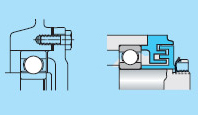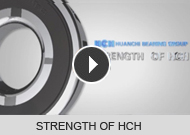- Main Clients and markets
- Customer Service
- Bearing Selection services
- Bearing Handling Service
- Bearing Fitting Service
- Lubrication Service
- Preload
-
Bearing cleanliness

External seals also have two main functions: to prevent lubricating oil from leaking out, and to prevent dust, water and other contaminants from entering the bearing. Similar to internal bearing seals, the external bearing sealing devices also divided into two types, non-contact type and contact type.
|
Non-contact seals: Non-contact radial shaft seals function by virtue of the sealing effect of a narrow, relatively long gap which can be arranged axially, radially or in combination. Non-contact seals, which range from simple gap-type seals to multistage labyrinths are practically without friction and do not wear, making them suitable for high speed applications. In order to improve sealing capability, clearance spaces are often filled with lubricant. |

|
|
Contact seals:Seals in contact are used to seal passages between machine components. These dynamic seals accomplish their sealing action through the contact pressure of a resilient part of the seal (the lip is often made of synthetic rubber) and the sealing surface. These contact seals are generally far superior to non-contact seals in sealing efficiency, although their friction torque and temperature rise coefficients are higher. |

|
The following chart lists the special characteristics of seals and other points to be considered when choosing an appropriate seal.
| Type | Seal construction | Name | Seal characteristics | Selection considerations | ||||||||||||||
|
Non- contact seals |

|
Clearance seal | This is an extremely simple seal design with a small radial clearance. |
Cautionary points regarding selection ●In order to improve sealing efficiency, clearances between the shaft and housing should be minimized. However, care should be taken to confirm shaft/bearing rigidity and other factors to avoid direct shaft-housing contact during operation. |
||||||||||||||

|
Oil groove seal (oil grooves on housing side) |
Several concentric oil grooves are provided on the housing inner diameter to greatly improve the sealing effect. |
Oil groove clearance (reference)
|
|||||||||||||||

|
Oil groove seal (oil grooves on shaft and housing side) |
Oil grooves are provided on both the shaft outer diameter and housing inner diameter for a seal with even greater sealing efficiency. |
●Oil groove width, depth (reference) width : 2 5 mm depth : 4 5 mm ●Three or more oil grooves should be provided. ●Sealing efficiency can be further improved by filling the oil groove portion with grease of which the viscosity grade is 150 to 200. |
|||||||||||||||

|
Axial labyrinth seal |
This seal has a labyrinth passageway on the axial side of the housing. |
Labyrinth clearance (reference)
|
|||||||||||||||

|
Radial labyrinth seal |
A labyrinth passageway is affixed to the radial side of the housing. For use with split housings. This offers better sealing efficiency than axial labyrinth seals. |
●Grease is generally used as the lubricant for labyrinth seals, ●Sealing efficiency can be further improved by filling the labyrinth passageway with grease of which the viscosity grade is 150 to 200. ●Labyrinth seals are suitable for high speed applications. |
|||||||||||||||

|
Internal slinger | By providing a slinger inside the housing, centrifugal force guides the lubricant flow back on the bearing and helps prevent it from dirtying the work environment. |
Cautionary points regarding selection
●By installation on the revolving shaft, these seal types make use of centrifugal force to aid lubrication, seal in lubricant and prevent the entrance of contaminants. |
|||||||||||||||

|
External slinger | By mounting a slinger on the outside of the housing, centrifugal force helps to prevent dust and other solid contaminants from entering. | ||||||||||||||||
|
Contact seals |

|
Z grease seal | In cross section resembling the letter "Z," this seal's empty spaces are filled with grease. The seal is commonly used with a plummer block (bearing housing). |
Shaft surface roughness (reference )
Shaft material (reference )
Cautionary points regarding selection |
||||||||||||||

|
V-ring seal | This design enhances sealing efficiency with a lip that seals from the axial direction. With the aid of centrifugal force, this seal also offers effective protection against dust, water, and other contaminants entering the bearing. Grease can be used on both sides of the seal. | ||||||||||||||||

|
Oil seal
|
Oil seals are widely used, and their shapes and dimensions are standardized under JIS B 2402. In this design, a ring-shaped spring is installed in the lip section. As a result, optimal contact pressure is exerted between the lip edge and shaft surface, and sealing efficiency is good. | ||||||||||||||||

|
Depending upon the direction in which the lip faces (in toward the bearing or away from the bearing) contact oil seals are very effective at preventing lubricant leakage from the housing or contaminants from infiltrating the bearing. | |||||||||||||||||





